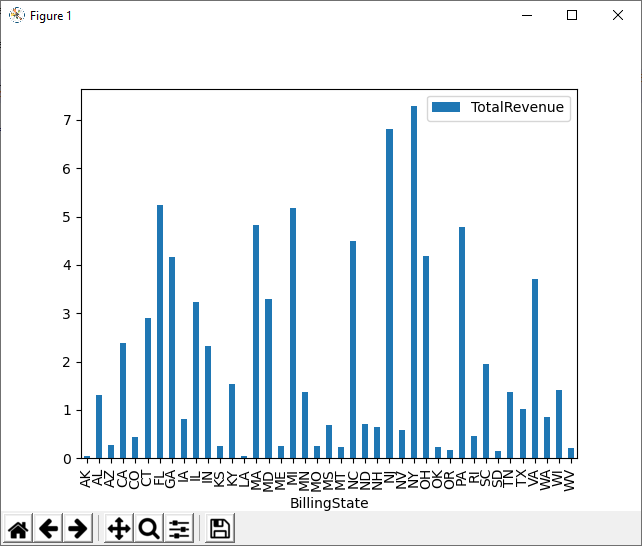Discover how a bimodal integration strategy can address the major data management challenges facing your organization today.
Get the Report →How to Visualize Azure Data Lake Storage Data in Python with pandas
Use pandas and other modules to analyze and visualize live Azure Data Lake Storage data in Python.
The rich ecosystem of Python modules lets you get to work quickly and integrate your systems more effectively. With the CData Python Connector for Azure Data Lake Storage, the pandas & Matplotlib modules, and the SQLAlchemy toolkit, you can build Azure Data Lake Storage-connected Python applications and scripts for visualizing Azure Data Lake Storage data. This article shows how to use the pandas, SQLAlchemy, and Matplotlib built-in functions to connect to Azure Data Lake Storage data, execute queries, and visualize the results.
With built-in optimized data processing, the CData Python Connector offers unmatched performance for interacting with live Azure Data Lake Storage data in Python. When you issue complex SQL queries from Azure Data Lake Storage, the driver pushes supported SQL operations, like filters and aggregations, directly to Azure Data Lake Storage and utilizes the embedded SQL engine to process unsupported operations client-side (often SQL functions and JOIN operations).
Connecting to Azure Data Lake Storage Data
Connecting to Azure Data Lake Storage data looks just like connecting to any relational data source. Create a connection string using the required connection properties. For this article, you will pass the connection string as a parameter to the create_engine function.
Authenticating to a Gen 1 DataLakeStore Account
Gen 1 uses OAuth 2.0 in Azure AD for authentication.
For this, an Active Directory web application is required. You can create one as follows:
To authenticate against a Gen 1 DataLakeStore account, the following properties are required:
- Schema: Set this to ADLSGen1.
- Account: Set this to the name of the account.
- OAuthClientId: Set this to the application Id of the app you created.
- OAuthClientSecret: Set this to the key generated for the app you created.
- TenantId: Set this to the tenant Id. See the property for more information on how to acquire this.
- Directory: Set this to the path which will be used to store the replicated file. If not specified, the root directory will be used.
Authenticating to a Gen 2 DataLakeStore Account
To authenticate against a Gen 2 DataLakeStore account, the following properties are required:
- Schema: Set this to ADLSGen2.
- Account: Set this to the name of the account.
- FileSystem: Set this to the file system which will be used for this account.
- AccessKey: Set this to the access key which will be used to authenticate the calls to the API. See the property for more information on how to acquire this.
- Directory: Set this to the path which will be used to store the replicated file. If not specified, the root directory will be used.
Follow the procedure below to install the required modules and start accessing Azure Data Lake Storage through Python objects.
Install Required Modules
Use the pip utility to install the pandas & Matplotlib modules and the SQLAlchemy toolkit:
pip install pandas pip install matplotlib pip install sqlalchemy
Be sure to import the module with the following:
import pandas import matplotlib.pyplot as plt from sqlalchemy import create_engine
Visualize Azure Data Lake Storage Data in Python
You can now connect with a connection string. Use the create_engine function to create an Engine for working with Azure Data Lake Storage data.
engine = create_engine("adls:///?Schema=ADLSGen2&Account=myAccount&FileSystem=myFileSystem&AccessKey=myAccessKey&InitiateOAuth=GETANDREFRESH&OAuthSettingsLocation=/PATH/TO/OAuthSettings.txt")
Execute SQL to Azure Data Lake Storage
Use the read_sql function from pandas to execute any SQL statement and store the resultset in a DataFrame.
df = pandas.read_sql("SELECT FullPath, Permission FROM Resources WHERE Type = 'FILE'", engine)
Visualize Azure Data Lake Storage Data
With the query results stored in a DataFrame, use the plot function to build a chart to display the Azure Data Lake Storage data. The show method displays the chart in a new window.
df.plot(kind="bar", x="FullPath", y="Permission") plt.show()

Free Trial & More Information
Download a free, 30-day trial of the CData Python Connector for Azure Data Lake Storage to start building Python apps and scripts with connectivity to Azure Data Lake Storage data. Reach out to our Support Team if you have any questions.
Full Source Code
import pandas
import matplotlib.pyplot as plt
from sqlalchemy import create_engin
engine = create_engine("adls:///?Schema=ADLSGen2&Account=myAccount&FileSystem=myFileSystem&AccessKey=myAccessKey&InitiateOAuth=GETANDREFRESH&OAuthSettingsLocation=/PATH/TO/OAuthSettings.txt")
df = pandas.read_sql("SELECT FullPath, Permission FROM Resources WHERE Type = 'FILE'", engine)
df.plot(kind="bar", x="FullPath", y="Permission")
plt.show()






